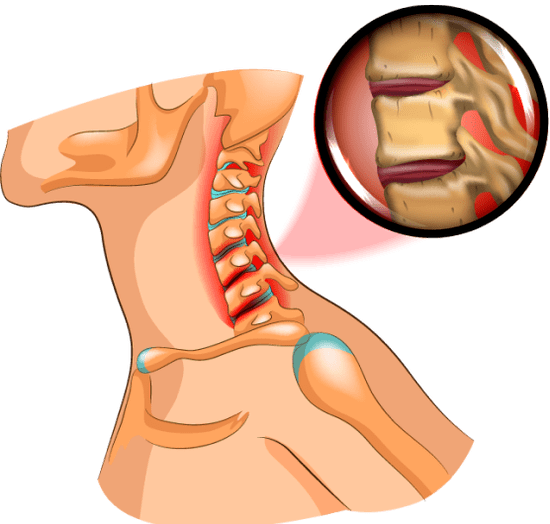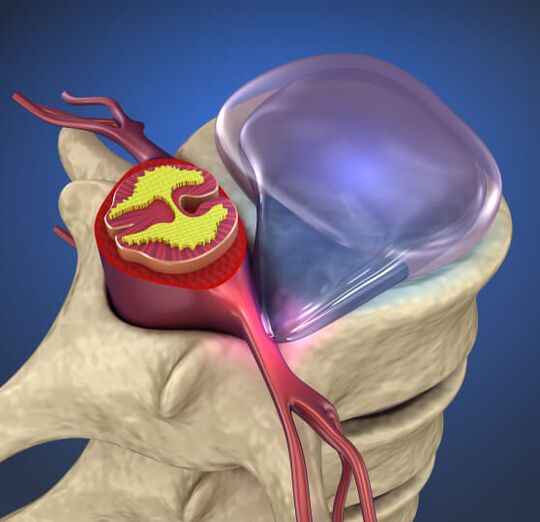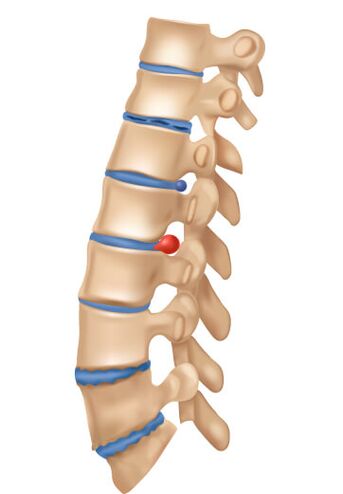Osteochondrosis is a medical term describing a violation of the integrity of the cartilage surfaces of bones. Most often the disease is associated with damage to the intervertebral discs.

Intervertebral discs are a kind of shock absorber that soften the pressure on the spine under load. Osteochondrosis worsens the quality of life, causing pain in the back, neck, head, tinnitus.
There are two views regarding the diagnosis. Experts abroad attribute the disorder to diseases of childhood and adolescence. It is thought to be more common in children because their bones are in a developing stage. Russian doctors diagnose osteochondrosis mainly in patients aged 25 to 55 years. The signs, causes and types of the disease in both cases are the same.
How to define osteochondrosis?
- Are there persistent or recurring back pain or muscle tension?
- Do you have goose bumps on your lower back or neck?
- Do you feel like "pulling" in the back?
- Do you feel pain when raising your arms or shaking your head to the sides?
- Do you have periodic dizziness?
- Do you have fits of noise, nausea?
If at least one answer is in the affirmative, it is worth contacting a specialist to conduct a study. If the diagnosis reveals a violation, the doctor will prescribe treatment and help protect yourself from more serious and painful symptoms.

What are the causes of osteochondrosis
The massive incidence of osteochondrosis is associated with the fact that people are most of the time in an upright position. In this case, the spine and the discs are under increased stress. If they sit, lie, and stand incorrectly, the discs lose their cushioning ability.
Over time, the lining of the disc cracks and hernial protrusions appear. They start to squeeze the blood vessels, the roots of the spinal cord, or the brain itself. As a result, pain, reflex tension in the muscles appears.
The risk group includes middle-aged and elderly people. Office workers, professional drivers, tall people are most often faced with this disease. Risk factors for developing severe symptoms of a disorder can be:
- flat foot;
- heredity;
- Overweight;
- hypodynamia.
The reasons for the appearance of disorders of the articular cartilage:
Handling heavy loads.
Poor posture when sitting, standing or lying down.
Injuries, overwork.
Excessive stress when practicing sport.
High air humidity and low temperature.
Activities associated with frequent changes in body position.
Types of osteochondrosis
Osteochondrosis can develop in any part of the spine. By localization, the disease is divided into: cervical, thoracic and lumbar. The latter type occurs in 50% of cases.
Lumbar osteochondrosis

A similar diagnosis is made for both men and women. The reason for this is the increased load that appears when walking, running, exercising and sitting for a long time. The lumbar spine consists of 5 vertebrae, between which there are discs that give elasticity. If the metabolic process does not occur, the intervertebral discs lose their properties and pain occurs.
Symptoms:
- Dull or sharp back pain that gets worse with movement.
- Pain in the legs, pelvic organs, sacral region.
- Reduced mobility or sensitivity.
- Atrophy of the leg muscles during the acute course of the disease.
Lumbar osteochondrosis should be treated. In the absence of treatment, dangerous complications can occur: sciatica, hernia, protrusion. As a result, the natural blood supply to the spinal cord is disturbed, which leads to paralysis of the lower extremities.
Cervical osteochondrosis
"Make sure you turn your head" - doctors urge. In this way, you can avoid the dangerous diagnosis of osteochondrosis of the cervical spine. The neck is the most mobile part of the spine. The department consists of 7 vertebrae. The disease appears as a result of metabolic disorders in the body, in the presence of salts in the neck or due to the frequent uncomfortable position of the head.
Symptoms:

- Headache;
- Pain in the region of the heart;
- Flashing "flies" before the eyes;
- Hearing impairment;
- Crunch in the cervical spine;
- Pain in the arm or shoulder joint;
- Numbness of the limbs.
Experts note that this type of disease is one of the most dangerous, as it can lead to poor circulation in the brain, migraines, dystonia, and more serious illnesses.
Thoracic osteochondrosis

Disturbances of the thoracic spine occur less frequently because the vertebrae are inactive. The pains that appear in this area of the body are felt by many people who are engaged in hard physical labor or have a sedentary profession. The cause of osteochondrosis can be a disturbed metabolic process, an increased load on the intervertebral discs.
Symptoms:
- Pain or tightness in the chest area.
- Pain between the shoulder blades when raising the arms.
- Skin sensitivity disorders.
In an acute disorder, two symptoms may appear: back pain and back pain. Back pain is accompanied by sharp chest pain, shortness of breath. With back pain, the pain in the region of the vertebrae of the department is not too strong, but gradually increases. The disease is often confused with other chest pathologies: heart attack, pneumonia, angina, etc. The diagnosis is made only by a specialist, based on examination and research.
Stages of osteochondrosis
- At the first stage, there are no obvious symptoms. With periodicity, there is discomfort in the spine, which is associated with fatigue or excessive physical exertion. The disease can be detected during a routine exam, x-ray or CT scan.
- The second stage is accompanied by a pain syndrome, as the process of destruction of cartilage tissue begins and the gap between the discs decreases. Pain at this stage is relieved with medication prescribed by a doctor.
- At the third stage, the deformities of the spine begin: the fibrous ring is ruptured, an intervertebral hernia appears. With the help of correctly prescribed treatment, it is always possible to improve the condition of the spine.
- The fourth stage is the irreversible changes in the spine, in which it becomes difficult for a person to move. Bone tissue grows between the vertebrae, connecting the vertebrae. Most often, this form of osteochondrosis leads to disability.
Diagnostic methods

To determine the extent of the disease, check sensitivity and reflexes, the doctor performs a physical examination. In addition, blood and urine tests are carried out, indicators of calcium metabolism are studied.
To establish an accurate diagnosis, diagnostic methods are used:
- Vascular ultrasound. Determination of the degree of impaired blood flow in the vertebral arteries.
- X-ray of the spine.
- UKT. Construction of a three-dimensional image of the study area to detect small movements of the vertebrae.
- UMRI. Study of the condition of soft tissues to assess the condition of the spinal cord and visualize the internal structure of the discs.
Treatment

Osteochondrosis is treated comprehensively. The main goal of therapy is to remove painful sensations, eliminate muscle tension and stiffness in movements that appear due to pain. It is important not to self-medicate, but to consult a specialist and follow the recommendations.
To treat the spine, the doctor prescribes nonsteroidal anti-inflammatory drugs that help relieve inflammation and swelling. Muscle relaxants are responsible for reducing muscle spasms. Ointments are used to relieve pain. Antioxidants and vitamins may be prescribed to protect nerve tissue.
Prophylaxis

It is possible to preserve the health of the spine and prevent the appearance of symptoms or complications of osteochondrosis by adhering to the methods of prevention:
- drink enough water, control body weight;
- eat foods rich in collagen;
- selection of an orthopedic mattress that supports the body;
- regular exercise.
Alternative methods can be tried: acupuncture, qigong or massage. Before starting any procedure, you should consult a doctor in order to ensure the health of the musculoskeletal system.























